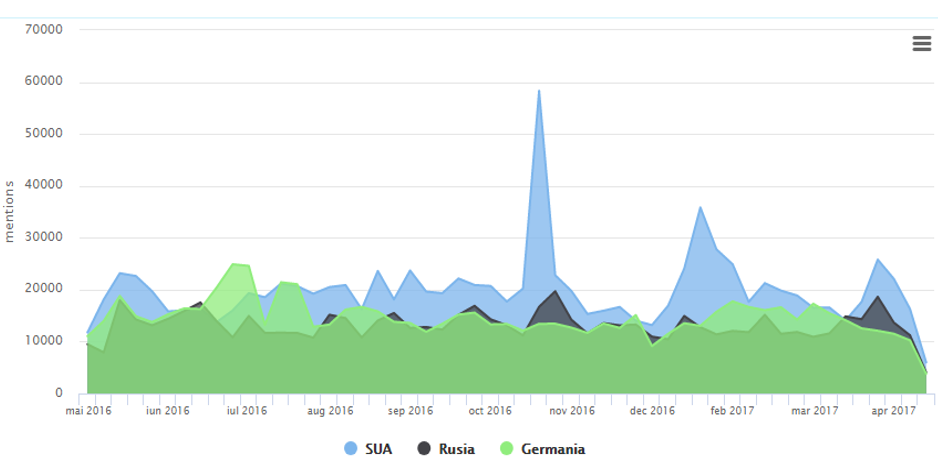Media analysis coordinated by CPD@SNSPA team. Authors: Dan Sultanescu & Daniel Buti. Online media monitoring data from December 2016 – April 2017.
For more details, ask CPD team – office@civicparticipation.ro
Romania is a country where, in recent years, pro-Western sentiment has begun to be questioned, even though this is still not perceived as a problem. The number of people who do not trust Western institutions has begun to grow and there is no longer an unconditional confidence in the Western model[1]. Without a proactive attitude from the two components of this model (the US and the EU), countries from Eastern Europe such as Romania become more vulnerable in the face of new types of threats. As shown in other of our studies, these threats can be of a non-military or indirect nature. They can be much more subtle, elusive and obviously difficult to counteract. In a society with low levels of civic participation, such developments can lead to serious social upheaval, thus distancing Romania from the Western project, and even to a weakening of the strategic relationship with the US in the medium term.
One area that is crucial in the current information war is online media, with all its details. In order to explore this area more, we conducted a special research on how the most important names of international leaders, countries, and institutions are reflected in Romanian online media.
[1] More details here – https://civicparticipation.ro/blog/project-go-west-vs-propaganda-romania-2016/ This is a CPD@SNSPA study from 2016. The analysis contains excerpts from the results of a 2016 CSCI survey, part of a research project specifically built by CPD to verify how the Romanian public responds to subjects of regional interest and even anti-Western themes. Pro-US and pro-Russia attitudes were a central element of research – the analysis also extracted some features of these audiences. We were interested to see what type of public is susceptible to such propaganda and the extent to which Romania’s relation with the West (and with the US in particular) is solid enough to withstand any challenge.
Therefore, we have turned to a new method – monitoring online media to map out the way the Romanian online media writes about the most important (relevant) leaders, institutions, and countries.
We wanted to see if the Romanian online media writes positively about the West and negatively about Russia, for example – and the conclusions are not necessarily the expected ones!
THE METHOD. We are interested in analyzing the media impact in Romanian online mass-media, regarding the most important names related to international relations (US, Russia, NATO, Germany, EU, Putin, Trump, Merkel, etc.). We also wanted to see which of the major countries and leaders are better perceived by the Romanian public, who has the most mentions and who appears in the most visible news. For this, we have developed a vast media analysis through extensive monitoring of as many online media sources as possible. Thus, with a media monitoring software, we gathered data on 10 key terms over a period of nearly 5 months (December 2016-April 2017), in which we centralized nearly 2 million mentions of these names. We decided to extract data regarding 5 leaders and 5 important countries or institutions – USA, Russia, Germany, NATO, European Union, Donald Trump, Vladimir Putin, Angela Merkel, Barack Obama and Klaus Iohannis. The extracted data, for these names, are able to show a relevant image of their impact in online media.

We collected data using a software provided by ZeList Monitor. ZeList Monitor is a monitoring and measuring tool for Romanian social media. Every week ZeList Monitor analyzes over 86,000 blogs, more than 41.000 Facebook pages, over 298.000 Twitter accounts and 2.800 online publications and 119 of the most important Romanian forums.
The period – we have collected data from December 1, 2016, until the end of April 2017. Thus, we have covered a period that reflects a change in the political situation in Romania (after parliamentary elections in December last year), as well as in the United States (after the presidential elections) and in Europe (with much activity generated by Brexit and other elections). Almost 5 months of media monitoring generated an impressive amount of data – over 1 million articles and nearly 2 million mentions of these names, in the news, online posts, comments, etc. This is sufficient to offer a very relevant and representative image of the online media in Romania.
This is not a sociological research, but an extended media analysis. The data reflects the number of mentions of the most prominent international names (countries, institutions, leaders) in the Romanian online press. From the measured data, we have extracted a number of press mentions, data on the profile of online sources (for press institutions such as newspapers, or forums – we have data about their geographic location in Romania, and for individual authors of online content such as Facebook accounts, Twitter accounts, blogs, or other social networks – we have demographic data like age or gender). We were also interested in the impact of the monitored mentions – by estimating a sum of audiences who potentially viewed the news (the viewership). The impact of the news was an important criterion in the analysis – because we could estimate how relevant mentions are to the measured names. We have data about evolution in time. We also have information about the quality of the mentions through a sentiment analysis – and here the conclusions are not necessarily positive for every country.

